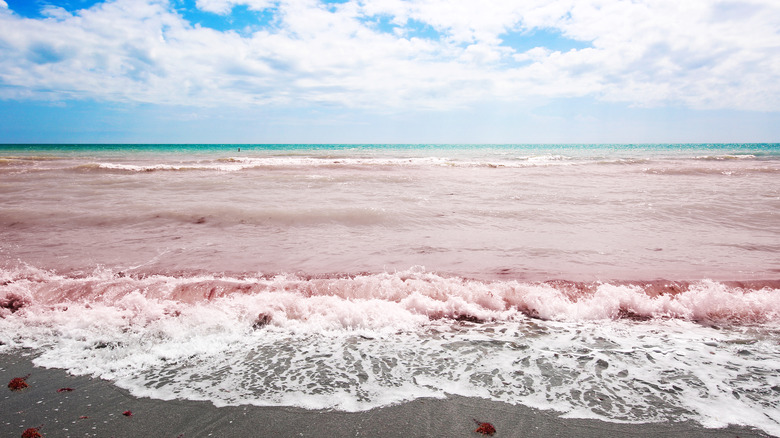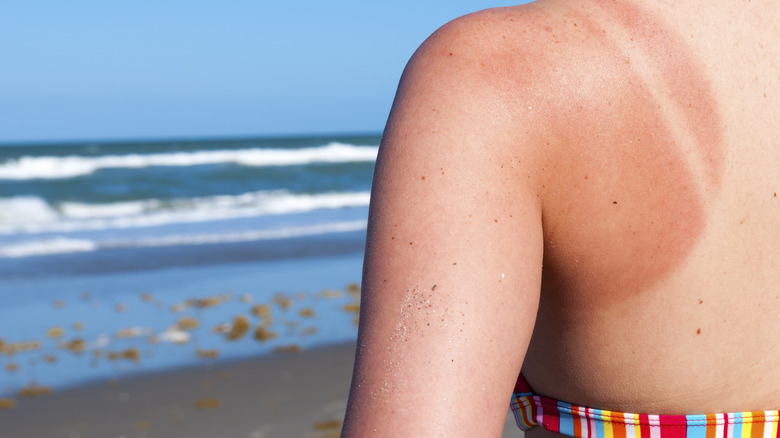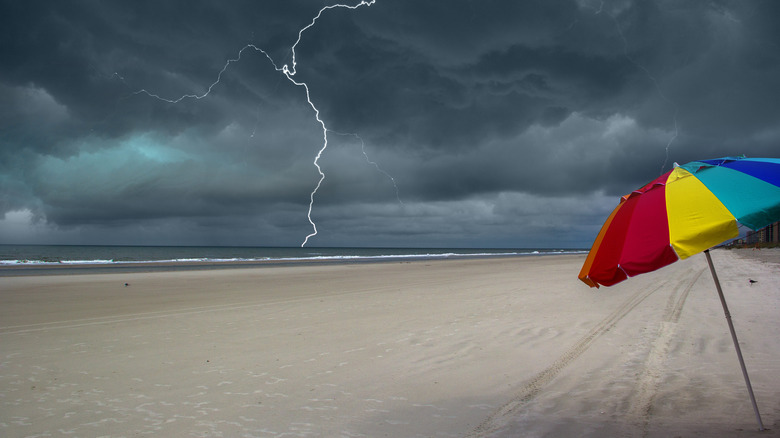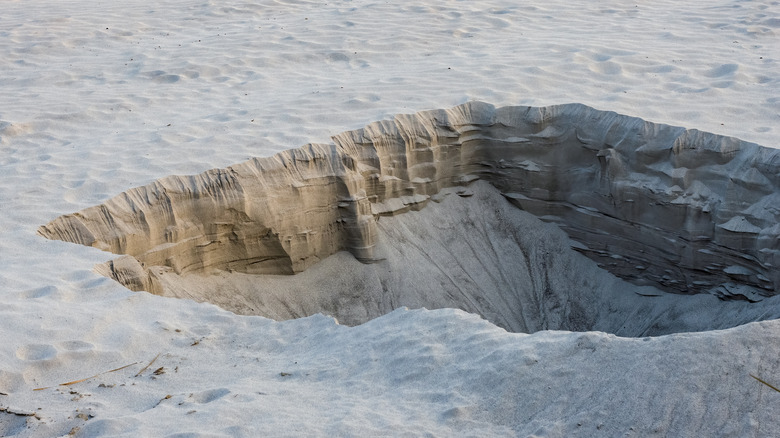Unexpected Dangers To Avoid During Your Next Beach Getaway
A day at the beach conjures images of sunny days, warm sands, and swimming in the cool ocean waters. Beach days have such a pleasant appeal, that, depending on which statistics you believe, the number of visits to American beaches is in the hundreds of millions or billions. Either way, it's safe to say a lot of people head to the beach fairly often. Unfortunately, not all of these beach days turn out nearly as pleasant as imagined. Far too often, a day at the beach ends in discomfort, illness, injury, or even death.
While most beachgoers are aware of the most sensationalized hazards that can be encountered during a day at the beach, such as dangerous types of sharks, there are numerous other potential pitfalls one can experience at the beach. So, although it is important to know what to do if you are stung by a jellyfish, for instance, there are several lesser-known dangers to avoid in order to have a safe day at the beach.
Rip currents, shorebreaks and big waves can result in drowning
Rip currents, or concentrated currents that flow away from shore, rank right at the top of the list of dangers for swimmers at the beach. According to the United States Lifesaving Association, more than 80% of the rescues performed by lifeguards are the result of swimmers being caught in rip currents. If you find yourself in this scary but survivable predicament, they advise not swimming against the current but rather swimming across it – parallel to the shore – to escape it, or allow the current to take you to the point where it diminishes or turns back shoreward.
Shorebreaks are areas where waves rise quickly to a peak, then break very close or even on the shore. This typically happens in areas where the beach slopes sharply to the water. The concern with a shore break is the power of the wave is more than capable of knocking people over, which can result in injury or drowning. Swimmers should keep in mind that waves will also peak and crest over sand bars or other shallow areas.
Algae and bacteria can cause illness and death
Another water-borne danger is the quality of the water. So, while beachgoers are usually concerned with creatures to beware of when swimming in the ocean, the bigger concern is sometimes the ocean water itself. One of the more common issues with ocean water quality is harmful algal blooms.
While algal blooms are part of the ocean ecosystem, with numerous beneficial blooms occurring on a regular basis, some blooms, such as what is commonly called red tide, release a toxin that is hazardous to both marine life and humans. This type of bloom is usually easy to recognize as the water is tinged a reddish tint and even if you can't see it, there is generally a foul smell accompanying it, which in part results from the deaths it causes among large numbers of various fish and marine creatures. The harm to humans is usually an allergy-type reaction of sneezing, coughing, and itchy eyes.
More serious than algae is bacteria. A number of bacteria are present in ocean waters — especially warm ocean waters. Many of these are known as "flesh-eating bacteria," with vibrio being among the most concerning. Swimmers typically will become infected with this bacteria if they swim or wade in tainted waters with an open wound. The resulting illness can be severe and more than 100 deaths are reported from vibrio each year. The majority of infections happen during the hottest portion of the year. Since it is impossible to visibly see signs of vibrio, it is suggested that anyone with an open wound refrain from getting in the water.
Heat exhaustion and sunburn can ruin a day at the beach
Although tourists often joke about the severity of their sunburns, turning as red as a lobster after a day at the beach is no laughing matter. The pain of a sunburn can be excruciating. It can also lead to dehydration and, in severe cases, shock. Additionally, repeated sunburn can increase the risk of developing severe issues later, such as melanoma. However, it is very easy to avoid a sunburn by simply applying sunblock (and reapplying throughout the day) and/or wearing caps and long-sleeve clothing.
While sunburn is a visible sign of too much sun, heat exhaustion is an even more severe, immediate concern. Basically, heat exhaustion happens when the body overheats. This can happen quickly on a hot, sunny beach day — especially for those not accustomed to being in the heat all day. To avoid this, it is important to stay hydrated, get in the shade as often as possible, and avoid overindulging in alcohol.
Lightning and bad weather responsible for a shocking amount of beach day deaths
Everyone envisions a bright, sunny day at the beach. However, rain showers, lightning, and stormy weather do happen at the beach. At times, it can happen unexpectedly. Often, when bad weather moves in, beachgoers are reluctant to let go of that idyllic day image and stubbornly stay through potentially dangerous conditions hoping the sun will peek out once again. While it is not uncommon for stormy conditions to pass through relatively quickly and for the day to resume a blissful tone, in the meantime, you need to take precautions when bad weather moves in.
While most everyone realizes lightning is a potentially dangerous natural phenomenon, they may be surprised to realize that in 2020 the National Lightening Safety Council reported that nearly two-thirds of the deaths from lightning take place while people are recreating. Furthermore, the majority of those leisure activity lightning strike deaths happen to people on or near the water. When you are on the beach, you are essentially the biggest target for a lightning bolt. So, if a storm begins to approach, don't hesitate to seek shelter. Even if you believe the storm will pass quickly, you should get in a vehicle, restroom facility, or other nearby shelter until it does. This may seem like an inconvenience and disruption to your beach day, but it can literally save your life.
Sand holes present a surprising beach hazard
One of the more iconic and enduring images of family times spent at the beach is of youngsters digging in the sand, building sandcastles, or perhaps burying themselves to the neck. While these activities are often thought to embody innocent fun, they also are responsible for a surprising number of deaths each year.
So, how could such a seemingly innocuous activity turn deadly? There are actually a few ways. For one sand holes can collapse, as sand is unable to hold its own weight as it dries. Additionally, if holes are dug close to the water's edge, they can fill with water either from below or from a rising tide. If someone ends up beneath the sand, there are no air pockets. Additionally, getting someone out of the sand, whether it collapsed on accident or they were intentionally buried, is exceptionally difficult because the sand continues to collapse on itself and forms around the body.
To ensure a safe day at the beach, it is advised to never dig a hole more than knee deep and never attempt to bury anyone in the sand. Additionally, it is important to fill any hole that is dug, even if it is an abandoned hole dug by someone else, as unfilled holes in the beach are another common cause of injury.





